The World’s Most Beautiful Libraries: Wiblingen and Schussenried Abbeys

It is one of the most dramatic about faces in architectural history. Mention German architecture and design today and images of clean lines and functional, not to say sterile, interiors come to mind. Yet somehow people we now associate with industrious and sober attitudes also produced the world’s most flamboyant examples of one of its most flamboyant architectural styles—Rococo, which flourished in Europe in the mid-18th century.
The countries of Central Europe as a whole are a veritable Easter egg hunt for pastel colored palaces with elaborate, sinuous ornamentation. And some of the most over the top Rococo structures ever built there were constructed by monks in their rural abbeys to house literary treasures. A pair of them, the siblings of Wiblingen and Bad Schussenried, in Southwest Germany, are the latest selection for our once-a-month series The World’s Most Beautiful Libraries.
You could swear, judging strictly from photographs, that you were looking at one of the world’s most opulent rooms. There’s the geometric marble floor guarded by gleaming porcelain and gold statues ringed by delicate columns of blue and pink marble. Add in two stories of books, doors with intricate marquetry, an undulating balustrade of blue marble marking a gallery girdling the second-floor windows, and a dramatic ceiling fresco jam packed with allegory and historic references and you’ve got yourself a tour-de-force showroom.

One of the painted wood sculptures at Wiblingen monastery library.
Except, only the ceiling fresco and the floors are as you see them.
The rest is just painted wood.
Just, however, is an awfully meager, underwhelming word in this instance. Because Wiblingen is undoubtedly one of the world’s most detailed and convincing spaces done in the illusionary style known as trompe l’oeil.
The library is housed in a large pink abbey located a few miles south of the city of Ulm. A monastery was founded there in 1093 for the Benedictines by the counts of Kirchberg. Over the next few centuries, the monastery became renowned for its scriptorium, the room where jaw-dropping illustrated literary works were handcrafted by monks. By the 18th century, the monastery—indeed the greater German-speaking world—was immensely wealthy thanks to decades of peace that followed centuries of war. With a new style (Rococo) all the rage largely as a reaction to the rigid splendor of Louis XIV, German princes, bishops, electors, merchants, and, yes, monks all outdid one another.
As Jacques Bosser notes in his book The Most Beautiful Libraries in the World, the plan for the two-story library in the abbey’s northern wing is a simple rectangular box measuring 74 ½ by 36 feet. The library project began in 1740 under Abbot Meinrad Hamberger, who wanted a space that he said would “awaken a new desire and a new love for spiritual and learned exercises among the monks.” This meant that not only did the space need to house literary works that could expand the minds of his monks, but it also needed to be a space that visually inspired its inhabitants.
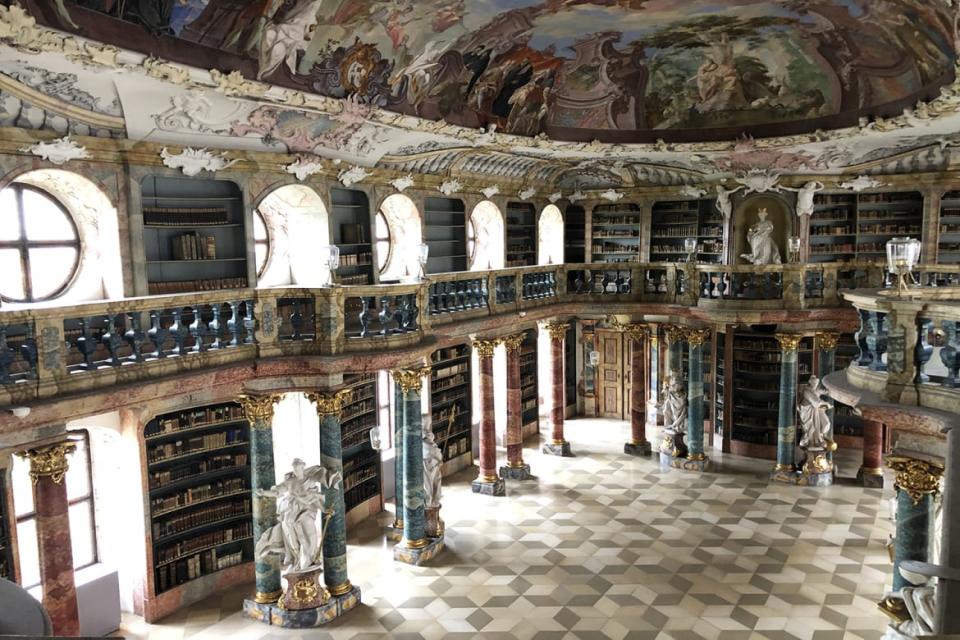
The abbot turned to Franz Martin Kuen, all of 25 years old, to complete spectacular frescos that as The New York Times once noted, turned Wiblingen into “an amazing testimonial to iconography… Here all knowledge, legend and allegory seems to have been captured in paint, marble, gilt, or plaster.” The young artist completed the ceiling fresco in just six months in 1744 using paints from natural pigments. Then he left for Italy, where he studied with Tiepolo and Piazzetta, returning to Wiblingen in 1750 to complete the paintings underneath the balcony, including the tone-on-tone (a painting style in which different shades of the same color are used) portraits of historical figures.
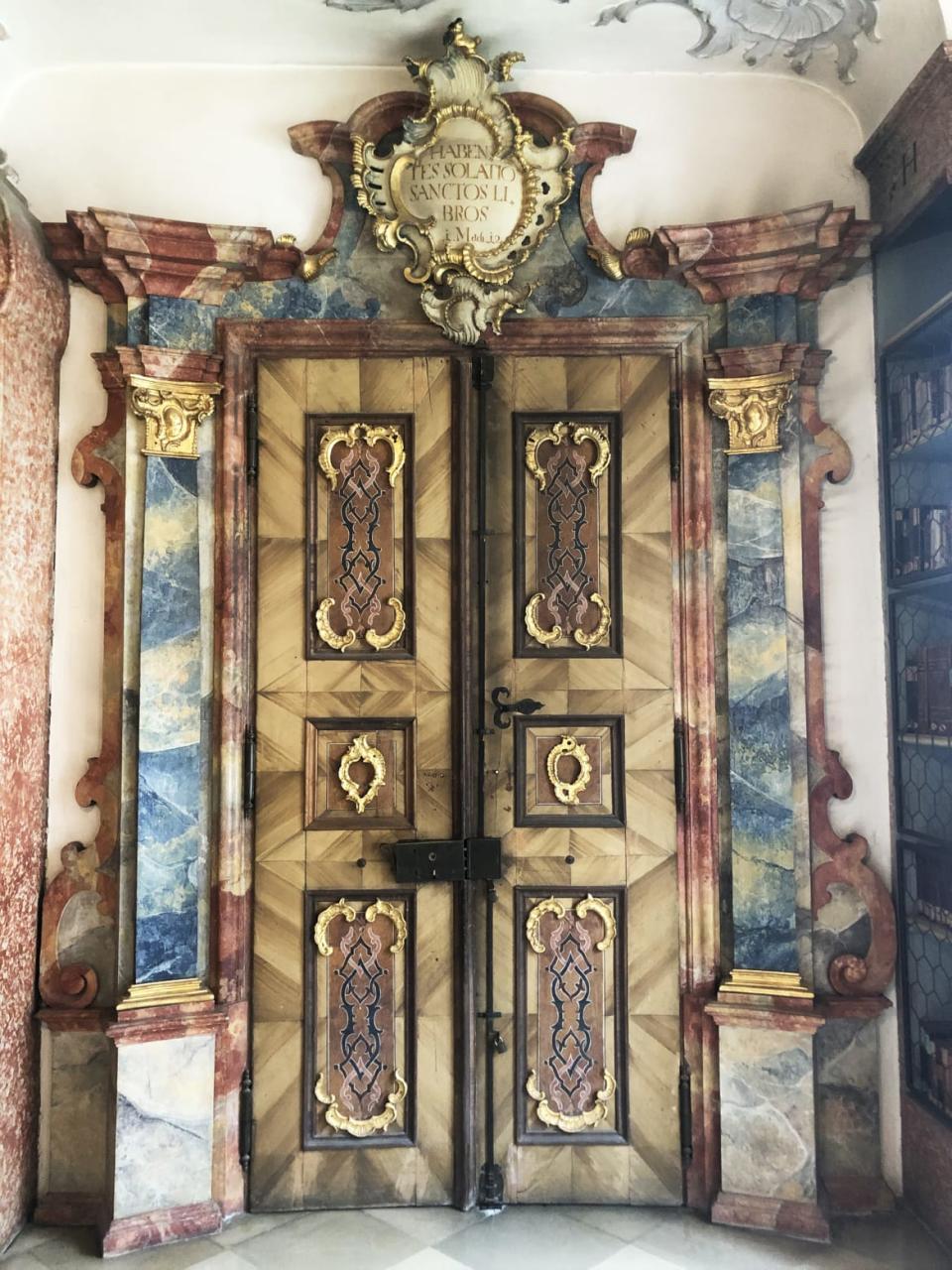
Even the doors are painted to look more ornate than they really are.
Standing at one end of the sumptuous hall, you’ll see opposite you on the second-floor gallery a statue within a niche, which actually opens to reveal a staircase down to the main floor of the library. Back on the first floor, what dominates are the marbleized stucco columns, completed by an unnamed artisan. The faux-marble pillars are just one of a number of magnificent illusionary works, the other notable ones being the entrance doors, which are painted to look like marquetry. (Also note what is inscribed in Latin above them: “In whom are hid all the treasures of wisdom and knowledge.”)
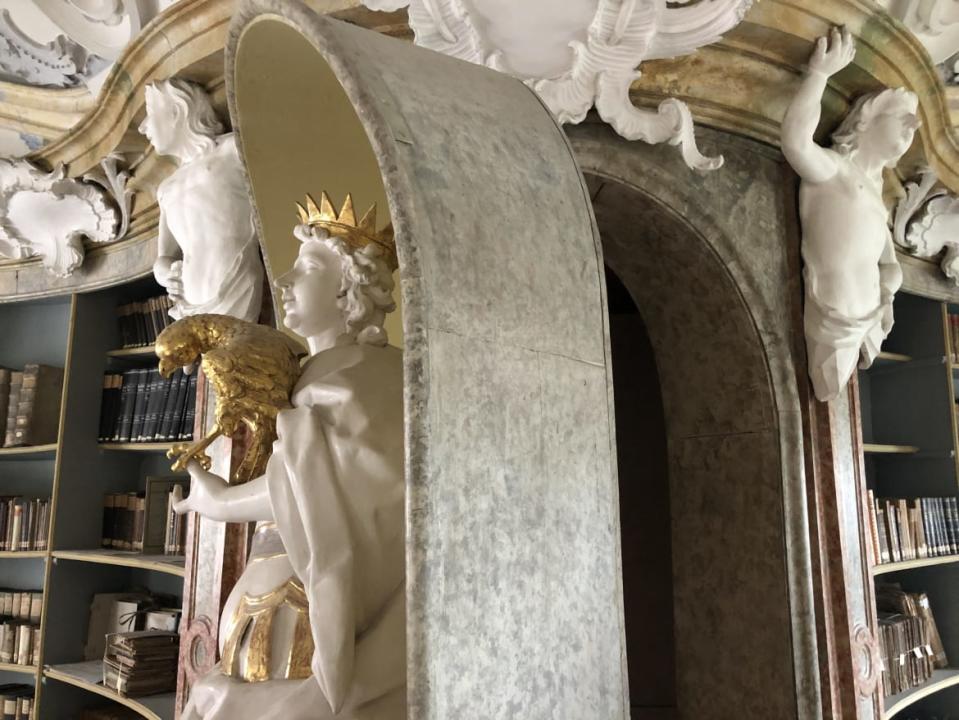
The secret door that connects the upper gallery to the main floor
The central floor is also ringed by eight statues that look as if they are of a shiny porcelain but are in fact painted wood. Carved by Dominikus Hermenegild Herberger, they represent Jurisprudence, Natural Science, Mathematics, History, Obedience, Renunciation of the World, Faith, and Prayer.
And what about the books! Only 96 originals remain out of a magnificent collection which once numbered more than 15,000. They were organized according to the theme of the scene in the fresco above them. However, most were stolen by the French during the Napoleonic wars and the rest taken by the king of Wurttemberg. As for the library and monastery, they were stripped from the church in the 1803 secularization the region underwent under Napoleon. (Germany before Napoleon was made up of hundreds of little states and principalities, many of which were controlled by the church. After, it had roughly three dozen and many of the assets of the church were liquidated and awarded to those who favored Napoleon.) Today, the monastery is part of the University of Ulm.
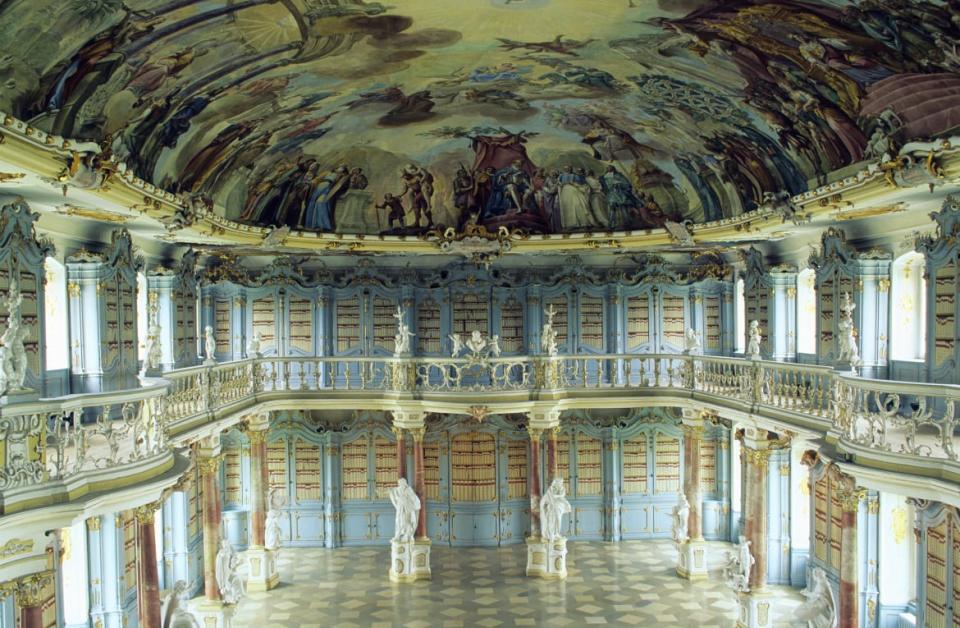
Schussenried Abbey, Library
Just 30 minutes south of Wiblingen, another monastic library was built and modeled after it. But at Bad Schussenried, it was almost as if somebody felt that the pink and blue raspberry color palette of Wiblingen was too gloomy, and we needed to up the cutesy to baby blue and millennial pink.
The abbey of Bad Schussenried has its origins dating back to 1183, but like Wiblingen the folks running it decided it needed a makeover in 1753. Also like Wiblingen, all is illusion here. Although don’t be too upset, actual marble columns would have been too heavy for the room.
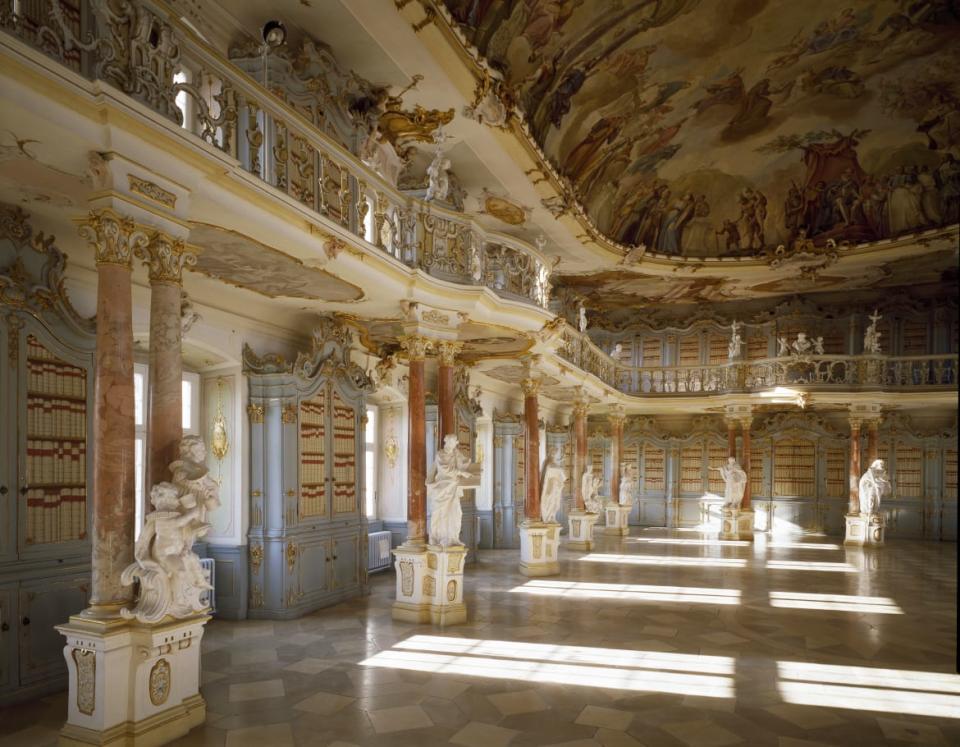
However, Schussenried never quite achieved the fame of Wiblingen. While elegant and totally somewhere I can see women in taffeta gowns reading and fainting, it doesn’t possess Wiblingen’s sense of shock and awe. Rarely will you see it in the giant coffee table books that round up the most beautiful libraries or the listicles that populate the web.
But it is in some ways more interesting.
Take, for instance the statues that ring the open floor. They are statues of children from the “wrong” religions: a little Lutheran, a Zwingli, a Muslim (with a turban and scimitar--iconic apparel after the Turkish Wars), and a Jew with a pointy hat. The statues are children, of course, because children just don’t know any better.
Unlike Wiblingen, Schussenried’s bookcases are covered with painted fabric to protect the books from sun and decay. Rows of books are painted on the fabric and their spines are all white to keep with the uniformity of the space. The two-story hall held twice the collection as Wiblingen (30,000 books) and so even the sides of the bookcases were built in with books. If you’re lucky, your guide will also open the centuries-old shelves to show the desk and chair the clever carpenters had incorporated.

The ceiling painting here was done by Franz Georg Hermann and is more solemn than that at Wiblingen, but unlike Wiblingen the ceiling and the gallery balustrade are decorated with dozens of wonderful white putti, all of which miraculously survived the centuries and are original.
Schussenried was also a victim (depending on your point of view) of secularization, and it was awarded to the countess of Schussenried and Weissenau. But, notes the Times, she lost the famed book collection to the king of Wurttemberg. The countess sued and managed to get some of them back, only to then be forced to sell them to pay for the repairs on the giant monastery she now owned.
In a wry twist of fate, the library with a statue of Lutherans as the “wrong” religion later became part of a mental hospital and was used by Lutherans there to hold services.
Today both libraries can be visited, although on my visits I couldn’t decide if I’d rather read or attend a ball in them. They are truly imaginative and exuberant spaces, two of the finest examples of Rococo anywhere in the world but also of our remarkable ability throughout the centuries to build awe-inspiring spaces to read a book.
Get our top stories in your inbox every day. Sign up now!
Daily Beast Membership: Beast Inside goes deeper on the stories that matter to you. Learn more.

 Yahoo News
Yahoo News 
